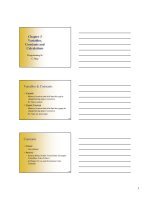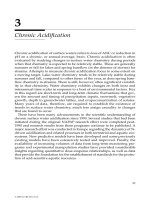chapter 3 consumer behavior
Bạn đang xem bản rút gọn của tài liệu. Xem và tải ngay bản đầy đủ của tài liệu tại đây (385.6 KB, 79 trang )
Chapter 3
Consumer
Behavior
Chapter 3: Consumer Behavior Slide 2
Topics to be Discussed
Consumer Preferences
Budget Constraints
Consumer Choice
Revealed Preferences
Marginal Utility and Consumer Choice
Cost-of-Living Index
Chapter 3: Consumer Behavior Slide 3
Consumer Behavior
There are three steps involved in the
study of consumer behavior.
1) We will study consumer preferences.
To describe how and why people prefer
one good to another.
Chapter 3: Consumer Behavior Slide 4
Consumer Behavior
There are three steps involved in the
study of consumer behavior.
2) Then we will turn to budget
constraints.
People have limited incomes.
Chapter 3: Consumer Behavior Slide 5
Consumer Behavior
There are three steps involved in the
study of consumer behavior.
3) Finally, we will combine consumer
preferences and budget constraints
to determine consumer choices.
What combination of goods will
consumers buy to maximize their
satisfaction?
Chapter 3: Consumer Behavior Slide 6
Consumer Preferences
A market basket is a collection of one or
more commodities.
One market basket may be preferred to
another market basket containing a
different combination of goods.
Market Baskets
Market Baskets
Chapter 3: Consumer Behavior Slide 7
Consumer Preferences
Three Basic Assumptions
1) Preferences are complete.
2) Preferences are transitive.
3) Consumers always prefer more of
any good to less.
Market Baskets
Market Baskets
Chapter 3: Consumer Behavior Slide 8
Consumer Preferences
A 20 30
B 10 50
D 40 20
E 30 40
G 10 20
H 10 40
Market Basket Units of Food Units of
Clothing
Chapter 3: Consumer Behavior Slide 9
Consumer Preferences
Indifference curves represent all
combinations of market baskets that
provide the same level of satisfaction to
a person.
Indifference Curves
Indifference Curves
Chapter 3: Consumer Behavior Slide
10
The consumer prefers
A to all combinations
in the blue box, while
all those in the pink
box are preferred to A.
Consumer Preferences
Food
(units per week)
10
20
30
40
10 20 30 40
Clothing
(units per week)
50
G
A
EH
B
D
Chapter 3: Consumer Behavior Slide
11
U
1
Combination B,A, & D
yield the same satisfaction
•
E is preferred to U
1
•
U
1
is preferred to H & G
Consumer Preferences
Food
(units per week)
10
20
30
40
10 20 30 40
Clothing
(units per week)
50
G
D
A
E
H
B
Chapter 3: Consumer Behavior Slide
12
Consumer Preferences
Indifference Curves
Indifference curves slope downward to the
right.
If it sloped upward it would violate the
assumption that more of any commodity
is preferred to less.
Chapter 3: Consumer Behavior Slide
13
Consumer Preferences
Indifference Curves
Any market basket lying above and to the
right of an indifference curve is preferred to
any market basket that lies on the
indifference curve.
Chapter 3: Consumer Behavior Slide
14
Consumer Preferences
An indifference map is a set of
indifference curves that describes a
person’s preferences for all
combinations of two commodities.
Each indifference curve in the map shows
the market baskets among which the
person is indifferent.
Indifference Maps
Indifference Maps
Chapter 3: Consumer Behavior Slide
15
Consumer Preferences
Indifference Curves
Finally, indifference curves cannot cross.
This would violate the assumption that
more is preferred to less.
Chapter 3: Consumer Behavior Slide
16
U
2
U
3
Consumer Preferences
Food
(units per week)
Clothing
(units per week)
U
1
A
B
D
Market basket A
is preferred to B.
Market basket B is
preferred to D.
Chapter 3: Consumer Behavior Slide
17
U
1
U
2
Consumer Preferences
Food
(units per week)
Clothing
(units per week)
A
D
B
The consumer should
be indifferent between
A, B and D. However,
B contains more of
both goods than D.
Indifference Curves
Cannot Cross
Chapter 3: Consumer Behavior Slide
18
Consumer Preferences
The marginal rate of substitution (MRS)
quantifies the amount of one good a
consumer will give up to obtain an
additional unit of another good, given
the same level of satisfaction.
It is measured by the slope of the
indifference curve.
Marginal Rate of Substitution
Marginal Rate of Substitution
Chapter 3: Consumer Behavior Slide
19
Consumer Preferences
Food
(units per week)
Clothing
(units
per week)
2 3 4 51
2
4
6
8
10
12
14
16
A
B
D
E
G
-6
1
1
1
1
-4
-2
-1
MRS = 6
MRS = 2
F
C
MRS
∆
∆
−=
Chapter 3: Consumer Behavior Slide
20
Consumer Preferences
We will now add a fourth assumption
regarding consumer preference:
Along an indifference curve there is a
diminishing marginal rate of substitution.
Note the MRS for AB was 6, while that
for DE was 2.
Marginal Rate of Substitution
Marginal Rate of Substitution
Chapter 3: Consumer Behavior Slide
21
Consumer Preferences
Indifference curves are convex because
as more of one good is consumed, a
consumer would prefer to give up fewer
units of a second good to get additional
units of the first one.
Consumers prefer a balanced market
basket
Marginal Rate of Substitution
Marginal Rate of Substitution
Chapter 3: Consumer Behavior Slide
22
Consumer Preferences
Perfect Substitutes and Perfect
Complements
Two goods are perfect substitutes when
the marginal rate of substitution of one
good for the other is constant.
Marginal Rate of Substitution
Marginal Rate of Substitution
Chapter 3: Consumer Behavior Slide
23
Consumer Preferences
Perfect Substitutes and Perfect
Complements
Two goods are perfect complements when
the indifference curves for the goods are
shaped as right angles.
Marginal Rate of Substitution
Marginal Rate of Substitution
Chapter 3: Consumer Behavior Slide
24
Consumer Preferences
Orange Juice
(glasses)
Apple
Juice
(glasses)
2 3 41
1
2
3
4
0
Perfect
Substitutes
Perfect
Substitutes
Chapter 3: Consumer Behavior Slide
25
Consumer Preferences
Right Shoes
Left
Shoes
2 3 41
1
2
3
4
0
Perfect
Complements
Perfect
Complements









